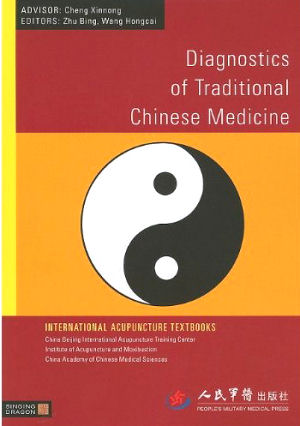Acupuncture and TCM Books
Diagnostics of Traditional Chinese Medicine
 Diagnostics of Traditional Chinese Medicine
Diagnostics of Traditional Chinese Medicine
Check New and Used Prices
The principles and practice of diagnostics are key to administering effective treatment in traditional Chinese medicine. The ability to recognise and diagnose symptoms and complaints correctly is fundamental to deciding on appropriate remedies, and this book provides a comprehensive introduction to all the principles that students and practitioners need to know.
The authors outline the key methods used in diagnosis, and describe the eight basic categories of ailment and disease: yin and yang, exterior and interior, cold and heat, and deficiency and excess. They provide detailed instructions on how to identify and rebalance the relative strengths of pathogens and Qi in the body, and how to differentiate between syndromes that might look the same, using traditional Chinese medicine methods. The book concludes with useful forms for completion in taking a diagnosis.
Combining practical instruction with detailed theory, this authoritative textbook, compiled by the China Beijing International Acupuncture Training Center (CBIATC), under the editorial direction of leading Chinese clinicians Zhu Bing and Wang Hongcai, is an excellent reference for students and practitioners at all levels.
Contents
1. Introduction. Concept of diagnostics of TCM. Content of diagnostics of TCM. Principles of diagnostics of TCM.
2. Diagnostics. Inspection. Observation of the vitality. Observation of the colour. Observation of the appearance. Observation of the head and five sense organs. Observation of the tongue. Auscultation and olfaction. Listening. Smelling. Inquiring. Chills and fever. Perspiration. Head and body. Ears and eyes. Appetite, thirst and taste. Sleep. Stools and urine. Menses and leukorrhea. Infants. Palpation. Feeling the pulse. Palpation of different parts of the body.
3. Differentiation of Syndromes. Differentiation of Syndromes according to the Theory of Eight Principles. Exterior and interior. Cold and heat. Deficiency and excess. Yin and yang. Differentiation of Syndromes according to the Theory of Etiology. Differentiation of syndrome according to the theory of six exogenous factors pestilential epidemics factors. Differentiation of syndromes according to the theory of the seven emotional factors. Improper diet, overstrain, stress. Traumatic injury. Differentiation of Syndromes according to the Theory of Qi, Blood and Body Fluid. Syndromes of qi, Syndromes of Blood. Syndromes of qi and blood. Syndromes of body fluid. Differentiation of Syndromes according to the Theory of Zangfu Organs. Syndromes of the heart and small intestine. Syndromes of the lung and large intestine. Syndromes of the spleen and stomach. Syndromes of the liver and gallbladder. Syndromes of the kidney and urinary bladder. Complicated syndromes of zangfu organs. Differentiation of syndromes according to the Theory of Six Meridians. Taiyang Syndrome. Yangming Syndrome. Shaoyang Syndrome. Taiyin Syndrome. Shaoyin Syndrome. Jueyin Syndrome. Transmission. Differentiation of Syndromes according to the Theory of Wei-defense, Qi, Ying - nutrient and Xue Blood. Weifen syndrome. Qifen syndrome. Yingfen syndrome. Xuefen syndrome. Transmission. Differentiation of Syndromes according to the Theory of Sanjiao. Syndrome of the Upper jiao. Syndrome of the Middle jiao. Syndrome of the Lower jiao. Transmission.
4. How to Write Case Report.
Reviews
Combining practical instruction with detailed theory, this authoritative textbook, complied by the China Beijing International Acupuncture Training Center (CBIATC), under the editorial direction of leading Chinese clinicians Zhu Bing and Wang Hongcai, is an excellent reference for students and practitioners at all levels...Although modest in size, these texts are packed with information...in terms of portability and cost...they make themselves serious contenders for the college bags of students of Chinese medicine... In terms of visual presentation, other than the obligatory yin-yang and five-phase diagrams, assistance is limited to a few flow diagrams, which may disappoint more visually-orientated learners. This drawback is largely compensated for by the consistent use of clear tables that facilitate both learning and quick reference. Despite the drawback of the simplification inherent in such texts, some of the chapters are excellent. The chapter on emotions and elements in Basic Theories, for example, is particularly good, as is the chapter on bianzheng in the Diagnostic volume. The chapters on pulse and tongue are also well-written, and designed for quick navigation to allow mere seconds to access, for example, the description and significance of a tense pulse or a grey tongue coating. As such...These texts offer simiple, portable, concise and well-structured information that is consistent with the TCM literature already available. On occasion, refreshingly original insights come from the teaching experience of the authors. Whilst theis series does not necessarily offer an educational panacea, it may just offer what is missing on the market - an affordable, accurate and accessible series of texts written specifically for a Western mindset and understanding. If the rest of this series of text books are as good as the two reviewed here, (Diagnostic of Chinese Medicine and Basic Theories of Chinese Medicine),Singing Dragon Textbooks wil definitely become part of the recommended reading of Chinese medicine courses ; student in the early stages of their TCM studies o those that require a fresh angle or portable material for revision should cerainly consider buying them.
-Journal of Chinese Medicine, Greg Meier
Author information
Zhu Bing teaches at the China Beijing International Acupuncture Training Center (CBIATC), an organisation founded in 1975 at the request of the World Health Organisation. CBIATC has a prestigious reputation as one of the world's leading training organisations in Traditional Chinese Medicine.
Wang Hongcai teaches at the China Beijing International Acupuncture Training Center (CBIATC), an organisation founded in 1975 at the request of the World Health Organisation. CBIATC has a prestigious reputation as one of the world's leading training organisations in Traditional Chinese Medicine.

Diagnostics of Traditional Chinese Medicine
Check New and Used Prices